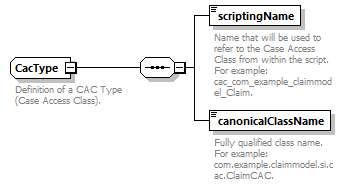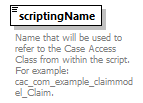| diagram |  |
||
| namespace | http://www.tibco.com/XPD/ScriptDescriptor/ | ||
| children | scriptingName canonicalClassName | ||
| annotation |
|
||
| source | <xs:complexType name="CacType"> <xs:annotation> <xs:documentation>Definition of a CAC Type (Case Access Class).</xs:documentation> </xs:annotation> <xs:sequence> <xs:element name="scriptingName" type="string"> <xs:annotation> <xs:documentation>Name that will be used to refer to the Case Access Class from within the script. For example: cac_com_example_claimmodel_Claim. </xs:documentation> </xs:annotation> </xs:element> <xs:element name="canonicalClassName" type="string"> <xs:annotation> <xs:documentation>Fully qualified class name. For example: com.example.claimmodel.si.cac.ClaimCAC.</xs:documentation> </xs:annotation> </xs:element> </xs:sequence> </xs:complexType> |
element CacType/scriptingName
| diagram |  |
||
| type | xs:string | ||
| properties |
|
||
| annotation |
|
||
| source | <xs:element name="scriptingName" type="string"> <xs:annotation> <xs:documentation>Name that will be used to refer to the Case Access Class from within the script. For example: cac_com_example_claimmodel_Claim. </xs:documentation> </xs:annotation> </xs:element> |
element CacType/canonicalClassName
| diagram |  |
||
| type | xs:string | ||
| properties |
|
||
| annotation |
|
||
| source | <xs:element name="canonicalClassName" type="string"> <xs:annotation> <xs:documentation>Fully qualified class name. For example: com.example.claimmodel.si.cac.ClaimCAC.</xs:documentation> </xs:annotation> </xs:element> |
WSDL documentation generated by XMLSpy WSDL Editor http://www.altova.com/xmlspy